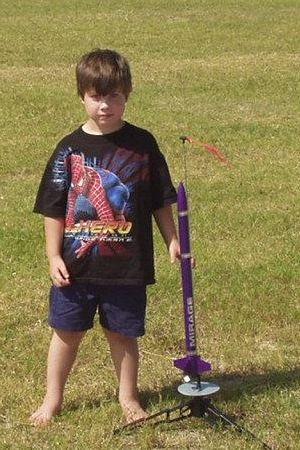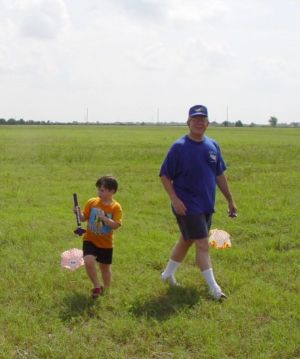| Construction Rating: | starstarstarstarstar |
| Flight Rating: | starstarstarstarstar |
| Overall Rating: | starstarstarstarstar |
| Manufacturer: | Quest  |

Brief:
The Mirage is an almost ready to fly payloader in the Quest Quick-Kit line with
pre-colored purple body tubes, nose cone, and plastic fins. The main body tube
and the payload section recover under separate 12" plastic parachutes.
Construction:
The kit includes:
- 1 paper body tube covered with nice purple paper
- 1 paper payload section covered with nice purple paper
- 1 purple plastic nose cone
- 1 purple plastic fin can
- 4 purple plastic fins
- 1 2.75" x 18 mm paper motor mount tube
- 1 black plastic twist-on fin retention ring
- 1 black plastic twist-on motor retention ring
- 18" of Kevlar® string for main body shock cord
- 12" of 1/8" elastic for main body shock cord
- 12" of 1/8" elastic for payload section shock cord
- 2 12" plastic parachutes
- 2 sets of parachute shroud lines
- 2 sets of stick-on reinforcements for parachute shroud line holes
- 1 red plastic display stand (which was cracked in my kit, but still works)
This was the third model rocket I ever built back in July of 2004. The instructions were very easy to follow and were in logical order. The actual build was simple and straightforward. The only problem I had was in fitting one of the four fins into its slot in the fin can. The fin did not want to fit as straight and securely as the other three but since I was using thin CA for glue, I did the best I could and glued the fin in place. It came out reasonably well.
Since I didn't plan to launch any actual payloads in the payload section, I glued the nose cone to the forward end of the payload section after the aft bulkhead and shock cord were in place. Also, I used number 10 snap swivels to attach the parachutes to the payload section and main body shock cords. This should reduce the chance of tangling the shroud lines and has worked well so far.
The Kevlar® shock cord is tied through an eyelet in the plastic fin can and motor retention assembly. This should be a very secure means of attachment.
The paper motor tube is mounted inside the fin can assembly by means of two slots in the motor tube, which fit onto two tabs inside the fin can. These two slots and tabs are the only thing holding the motor mount in the rocket but they have worked well so far.
Finishing:
No finishing was required since the body tubes, nose cone, and fins and fin can
were all purple straight from the bag. There were three adhesive stickers that
wrap around the body and payload section, plus two "Mirage" stickers.
The rocket looks fine with the stickers, all of which fit great.
Construction Rating: 5 out of 5

Flight:
Recommended motors are the A6-4, B6-4, C6-3, and C6-5. I have flown this rocket
6 or 8 times since the summer of 2004 and have used A8-3, B6-4, and C6-5
motors. All flights went well, although there have been some minor problems
with the parachute shroud lines on the main parachute. There has not been any
damage to either body section or to any of the fins.
Every flight has been nice and straight with no wobbling and only minor weathercocking, if any at all.
Recovery:
Shock cords are Kevlar®/elastic
on the main body section, and an elastic loop through the payload section
bulkhead. Nothing new or different here, and there have been no problems with
either shock cord.
Recovery is fine if it's not too windy. The field I fly at, Paul D. Rushing Park in Katy, TX, is big enough that some wind drift is okay but some recovery walks have been fairly long. All flights have been recovered within the boundaries of the park, so that's a good thing.
The only damage I've seen is tangling and/or detachment of some parachute shroud lines on the main body's parachute. Those snap swivels aren't doing quite as well as I had hoped. I probably can't blame that on the design of the rocket, though.
Flight Rating: 5 out of 5
Summary:
The Mirage is a great rocket for beginners and it continues to be one of my
favorites even though I haven't flown it much lately. My son loves it and wants
to fly it all the time.
Main PROs: Pre-colored body tubes, plastic fin can and snap-in fins. Great flights. Ease of flight prep using the Quest Quick-Kit motor retention system with the twist on/off plastic retention ring.
Main CONs: The motor mount tube could probably stand to be retained at more than two points, to keep it aligned better if nothing else.
Overall Rating: 5 out of 5
Sponsored Ads
 |
 |











